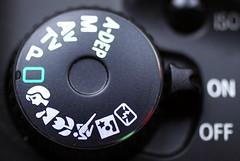 Continuing the the series of articles on the different shooting modes available on many EOS cameras it's time to look at one of the modes in the creative shooting section of the mode dial; A-DEP.
Continuing the the series of articles on the different shooting modes available on many EOS cameras it's time to look at one of the modes in the creative shooting section of the mode dial; A-DEP. Canon divides the mode dial on the EOS xxD, EOS xxxD and EOS xxxxD series models in to the basic zone and the creative zone. Modes in the creative zone are typically P, Tv, Av, M, A-DEP, Bulb and also the C modes. Choosing a creative zone mode gets you the full range of options, and you will even find that more menu tabs display than when using the basic zone modes.
A-DEP mode is designed to automatically choose the optimum settings to deliver an image with all the subjects covered by the AF points being in focus. A-DEP is one of the most automated and clever modes. First thing you notice is that the camera will always select all the AF points, you can't choose your preferred centre AF point for example. Then the camera looks at each focus point in turn to determine the closest subject and the furthest. Factoring in information about the lens then the camera calculates the required focus distance and the aperture to give sufficient depth of field to allow the closest subject and furthest to be in focus. Often the calculation throws up some surprises as to how little you need to close the aperture for a given depth of field and also that the lens never seems to need to be set to infinity. Remember the camera knows about the 1/3 in front of the AF point and 2/3 behind that is the usual for depth of field calculations.
Some photographers think of A-DEP as a kind of aperture priority mode, though in fact it's not just choosing the aperture and hoping (or knowing) the end result, it's using knowledge of the lens and the focus points to give you the precise results. Often used for landscape work with subjects in the foreground and the scene stretching in to the background A-DEP is equally useful for taking frame-filling portraits ensuring that only the main subject covered by the AF points is sharply focussed.
Like many of the creative modes you get to choose from a wide range of settings including:
- Metering pattern
- Picture Style
- Colour profile
- White balance including white balance shift & bracketing
- Auto exposure bracketing
- Exposure compensation
- Flash exposure compensation
- Drive mode selection
- Flash usage - though if you use flash the camera works like it's in Program (P) mode
- Image quality / image type
- ISO speed setting
- AE lock / FE lock
- AF lock
AF mode is set to one-shot with all the AF points active. So the key here is to make sure the AF points cover the correct parts of the scene you want in focus.
Blinking aperture or shutter speed settings in the viewfinder indicate troubles
If the shutter speed in the viewfinder shows a blinking 30s then the subject is took dark and you need to change the ISO to a higher setting - to avoid an underexposed shot. Similarly if it shows 8000 blinking then you have too bright a scene and need to drop the ISO or use a neutral density [ND] filter to avoid an overexposed shot.
If the aperture blinks this indicates that the exposure level is correct but that the camera couldn't achieve the needed depth of field, usually you need to use a wider angle lens or move further back from the closest subject.
-blabpictures-


No comments:
Post a Comment